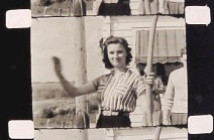If you are yourself adept at handling and projecting film, you will be in a good position to preview your material and place it in an appropriate order for transfer, perhaps even indicating how you would like the footage to be “chaptered” on a DVD. Or, if you have a relatively small collection of well-labeled material, you may be able to provide the transfer service with directions as to how you would like the material to be presented.
Often, however, inheritors of films find themselves with a large quantity of unlabelled film reels and no means of previewing the material. Rather than having the entire collection transferred at significant expense and in a random order, it would be ideal to find a way of previewing the films so that you can note the content, identify the footage of most significance, and arrive at a plan for both access and preservation needs.
If you have a family projector along with your films, it may not be difficult to get it working, especially if you still have a user’s manual. However, it is very possible to damage home movies by projecting them on a dirty or misaligned projector, or by failing to thread the machine properly – and if a film already has any damage or weak splices, or if it has shrunken beyond the tolerances of a machine, further damage is assured. Small hand-cranked film viewers / editors can be somewhat gentler on film elements if clean and used properly; however, care must be taken in order to avoid scratching or mangling your films whenever they are in contact with moving parts. If you intend to preview your film using projectors or viewers, explore this excellent reference site for film-handling guidelines. Another approach would be to find a film archive in your area, or perhaps a university film department that might be able to lend a hand. The National Film Preservation Foundation has a regional directory of archives that have conducted film preservation projects in the past; you can ask any local institution for referrals to others if they can’t help you themselves.
Home Movie Day only comes once a year, but many of the people who organize and participate in the events do film preservation work year-round. If there is a Home Movie Day in your area, try contacting the organizers to see whether the projectionist or a trained archivist might be available for hire to assist you with previewing your films. It might also be worthwhile to ask a local transfer provider for help in previewing your material. These are all good places to check for clean, well-maintained, and gentle viewing equipment you can borrow or use on-site to look at your films before having them transferred.

